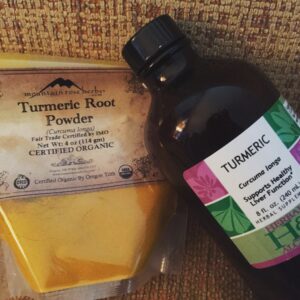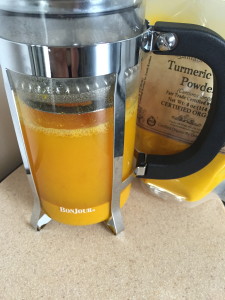
Plant Profile: Turmeric
Botanical Information
Latin Name
Curcuma longa
Plant Family
Zingiberaceae
Part Used
Rhizome (underground stem that sends out roots and stalks, a mass of roots)
Growing it
I left my chance to grow turmeric behind when I moved from Florida to New Jersey. Unfortunately I did not take advantage of my life in a tropical climate for growing it and I am not alone, few choose turmeric as a garden plant. Turmeric requires climates that never dip colder than 65 degrees Fahrenheit and although planting in pots later to move inside for warmth is an option, I think it safest to leave this plant to the hot, humid weather it loves. Correspondingly, most turmeric is produced in places like Costa Rica or India as well as other southeastern Asian countries. Hawaii is also a good location for cultivation. If this is home for you and growing turmeric is an interest, plant it as the little root cuttings called rhizomes which can be purchased at Indian specialty markets, Whole Foods markets or online. It does not grow from seeds. There is a school of thought from those who are able to use fresh turmeric that there is no comparison to dried, the benefits of fresh both in flavor and medicinal value far surpass that of dry.
Buying it

With its rise in popularity, powdered turmeric is available everywhere, truly an advantage over buying raw turmeric and attempting to powder it. That process requires first cooking the turmeric in water to soften, then cutting into small pieces, drying and then grinding. Besides the multiple steps and the need for proper equipment like a food dehydrator or spice grinder, this will turn everything you use yellow. The ability to buy the powder makes using turmeric easy and convenient. As with all herbs it is best to stick with certified organic brands if possible, usually there are options in larger supermarkets. For bulk amounts, I buy directly from trusted herbal suppliers such as Mountain Rose Herbs or Horizon Herbs. There are also lots of online options, such as Frontier Co-op, even Amazon.
Characteristics
Turmeric turns everything yellow, prepared foods, cooking utensils, and even skin when touched. The culprit is curcumin, turmeric’s most celebrated constituent, a natural yellow dye also known as diferuloylmethane. Curcumin constitutes 2-5% of a turmeric plant and is revered for its multiple therapeutic abilities. The importance of turmeric’s color is not to be overlooked. It is known as the golden healer, Indian saffron, and yellow ginger. As part of the energetic quality of a plant, yellow signifies affect on the liver and gallbladder, either in a good or bad way. In the Five Element theory of Traditional Chinese Medicine, yellow is associated with digestion and absorption of nutrients. From a nutritional perspective, turmeric is a source of vitamin C, potassium, iron, manganese, copper, Vitamin B6, and omega-3 fatty acids if consumed in a significant amount, as well as a rich supply of flavonoids and carotenoids, two important classes of antioxidants. For me yellow turmeric symbolizes sunshine: warm, dry, therapeutic, and comforting. Large amounts should not be used when pregnant or if history of gallstones or stomach ulcers or gastroesophageal reflux.
Taste
The scientific taste descriptive for turmeric is bitter, acrid, and pungent which translates for me as a sharp and biting warm type of flavor packing in a lot of strong taste sensations. It stimulates taste buds, wakes them up with zest but still has a touch of sweetness that can be addictive. It is a mix of gingery, peppery, earthy, citrusy, woodsy flavors that somehow enhance the foods that mix with it. Turmeric adds subtle warmth and once you have tasted it, there is no forgetting it.
Aroma
The epic King’s American Dispensatory, the botanical Bible, describes the aroma of turmeric as peculiar and fragrant. It definitely has a distinctive odor, one that often conjures up the thought of Indian cuisine. It will not cause a sneeze, but does have a bit of a pepper smell, mixed with ginger and citrus, sort of hard to describe, an aroma that changes as it transforms from fresh powder to spice cooked in a dish, where it seems to get even stronger.
Folklore
This herb is old, 4000 years old. Its uses, beliefs, and traditions originate from India and are vital still in rural areas where there may be no doctors or pharmaceutical medicines, only folk remedies that seem to have always worked. Dictionary references cite turmeric’s name as originating from the old French terreméryte or the Medieval Latin terra merita, both translate as meritorious or worthy earth. But the Sanskrit language has fifty-three different names for it, words that mean plenty or lucky and often refer to its signature yellow color, such as the Ayurvedic haldi. Even the Chinese name jiang huang translates to ginger yellow, which also signifies a close relation to ginger, jiang means ginger, huang means yellow. Often turmeric is compared to saffron and the Sanskrit kunkuma, which means saffron, is likely the word origin of curcumin. Ancient systems of medicine have used turmeric for centuries to boost the immune system, fight infections, and heal wounds. Turmeric paste or powder is used topically, added to hot milk and as an essential ingredient in cooking eaten daily, Indian folklore holds that if you do not, you may die. The idea that turmeric is essential to life is highlighted in its ritualistic importance to Hindu women throughout their life cycles. Rituals include bathing in turmeric at puberty and erotic symbolism during weddings, once married a woman wears a string on her wrist smeared with turmeric. In contrast, a widow must not touch the spice. Turmeric paste is applied to the face as makeup and a new dress is marked with it for luck before being worn. It is alleged that turmeric will keep away evil spirits who hate the smell of it burning and it is used during worship ceremonies as a sacred offering of respect for gods and elders.
Culinary and Cooking
That this spice is used in cooking is well known. As an integral part of curries, Indian, Middle Eastern, African, Thai and other Asian cultures have relied on it for centuries. Marco Polo bequeathed it Indian Saffron and brought it to Europe as a less expensive substitute; indeed it mimics saffron with a strong distinctive flavor and the ability to donate to all dishes its yellow color. But the sacred aspect and vast medicinal nature deem it a wonder food for Indian cultures. It is more than just a spice; it is a staple. Most food made with turmeric is referred to as savory, which means having a spicy, pleasant taste or smell without being sweet. Crunchy snacks, samosas, meat and vegetable curries, rice, and lentil dals all would be lost without turmeric. It is indispensible for condiments including chutneys, pickles, and even desserts. As a beverage, turmeric is used in teas or mixed with milk and honey for the warming golden milk, a beloved remedy for colds and flus. Where turmeric grows, the leaves are steamed as a wrap for meats, vegetables, and rice. Anytime curry powder is used, turmeric is likely a part. It is used as a deep yellow food coloring for orange cheese, yellow mustard, lemon yogurt, banana pudding, butter, and salad dressings. If it splashes on clothes there may be left a permanent yellow stain, but maybe that will bring good luck. Turmeric is often combined in traditional recipes with milk, coconut milk, eggs, butter, or ghee all of which have the ability to enhance the absorption of medicinal components. Spice blends used in curries have this same effect.
Beneficial Qualities
Turmeric is one herb whose list of benefits is long. The best place to start untangling all that it does is to focus on places in the body that it has the highest affinity toward, the liver, gallbladder, and digestive tract. In the liver, turmeric is the protector and detoxifying assistant. In the gallbladder it is the stimulator of bile production and in the digestive tract it is the healer of inflammation. This is a well-studied herb, with human clinical trials that support its antioxidant, anti-inflammatory, anticancer, and antibacterial activity. It can be used to aid in arthritic pain relief, healing of gastrointestinal conditions such as ulcers, diverticulitis, and leaky gut syndrome, and for cancer prevention. Its most ancient uses were likely as a yellow dye and as a paste applied to the skin for healing wounds, which would still be a great way to use it as long as yellow skin is on your acceptable fashion list. The question remains whether using curcumin standardized extract alone or powdered turmeric from the rhizome is best. While curcumin certainly is responsible for significant healing properties, there are hundreds of beneficial plant compounds in the whole turmeric plant including the volatile oil turmerone, which is highly hepatoprotective. The idea of using turmeric in its entirety is supported by the idea that we still do not fully understand all of the healing properties of plants; isolating one compound may mean missing out on some of the benefits. With all of our daily environmental toxin exposure, whether it is curcumin or turmeric, including this herb either as a food spice or as a supplement can only prove meritorious (worthy).
Herbal Preparations

Infusion: the ultimate preparation for most medicinal effect is to have a fresh turmeric rhizome, which is actually a mass of roots that begins with an underground stem and grows shoots and other pieces of root. Picture ginger which is also a rhizome. The tea should be prepared from the dried turmeric root that has been freshly powdered using a commercial grade spice grinder. Measure ½ teaspoon of the powder, pour 8 ounces of hot water over the powder and steep covered for 45 minutes, then strain.
Juice: Peel a 5 inch piece of fresh turmeric rhizome. This will turn your hands yellow as well as any utensils or cutting board. Soaking in soapy water for about five minutes will clean the yellow stains. Bring a 16oz of water to boil, add peeled turmeric and simmer for 20 minutes, the water will turn deep yellow. Cool. Pour water and turmeric into blender and blend until smooth.
Syrup: 1 oz or 2 Tablespoons turmeric powder to 2 cups of water. Simmer, stirring occasionally to break up the clumps. Reduce to 1 cup and add 1 cup of sugar, heat gently to dissolve.
Tincture: To prepare an alcohol extraction of turmeric with fresh turmeric the recipe is 1 part turmeric to 2 parts liquid, for dried use 1 part turmeric to 4 parts liquid. The alcohol is diluted to 60%.